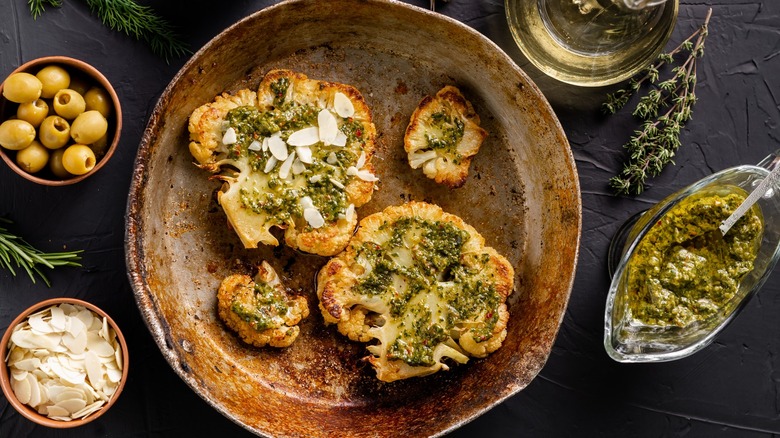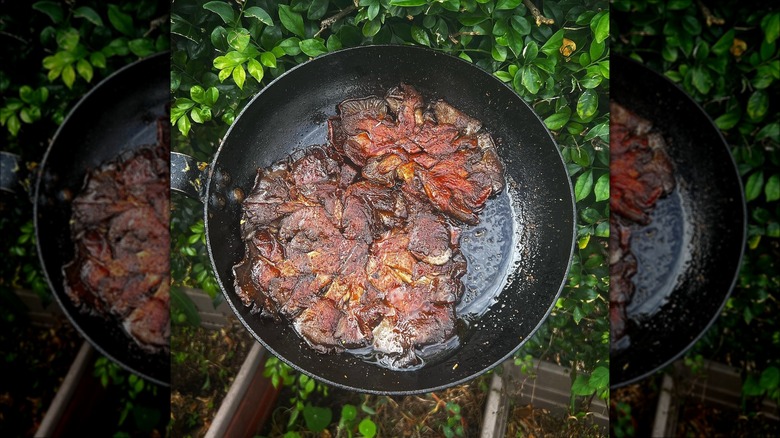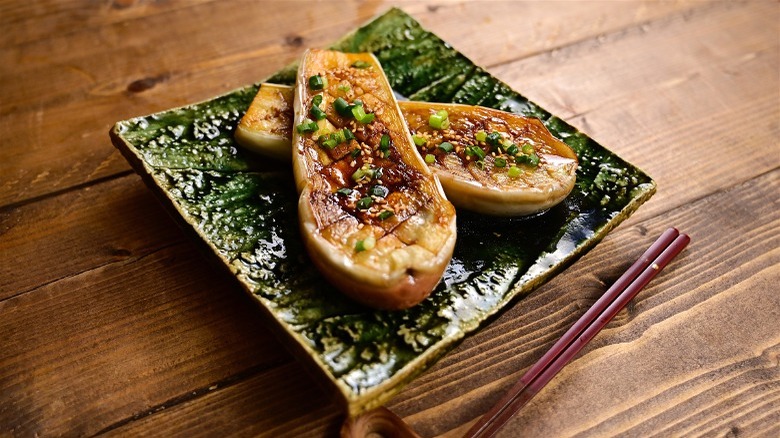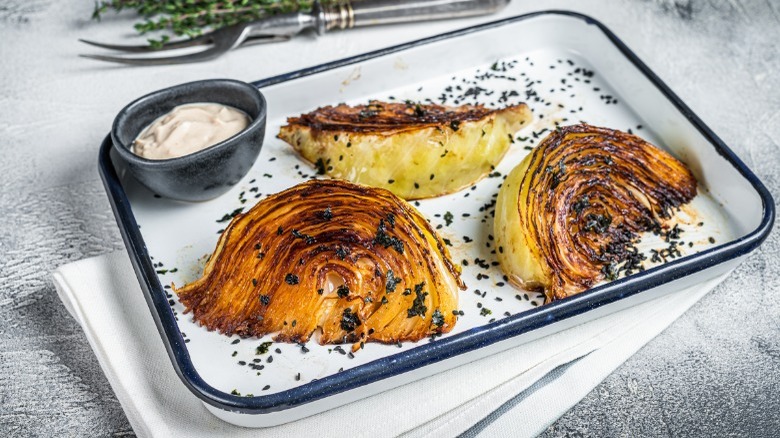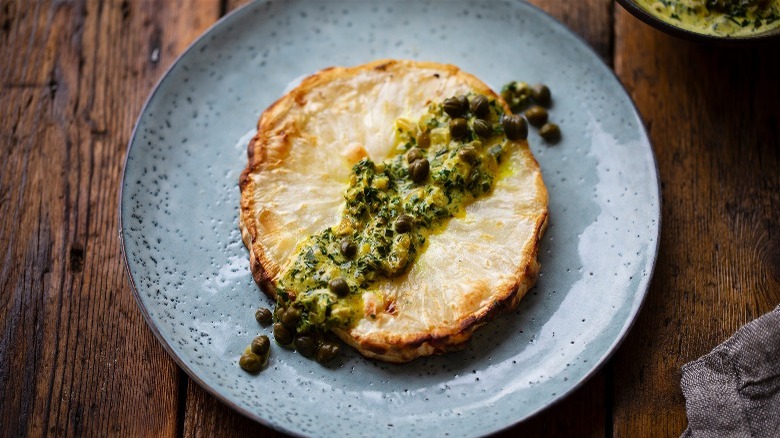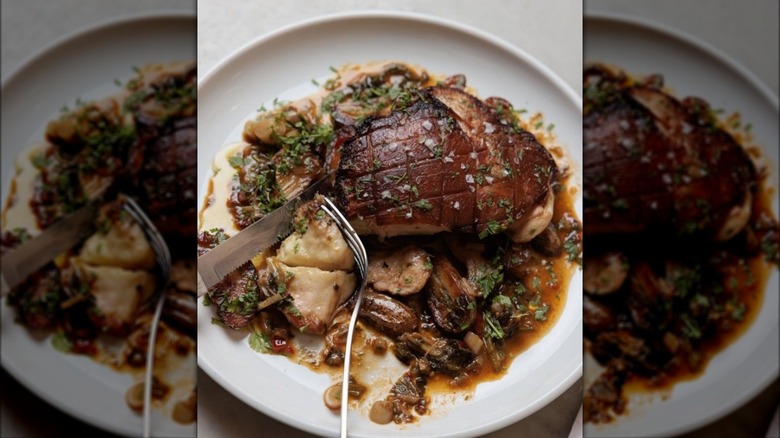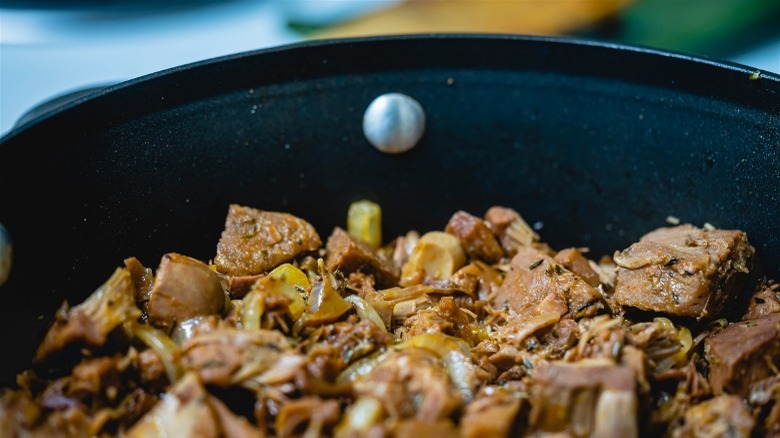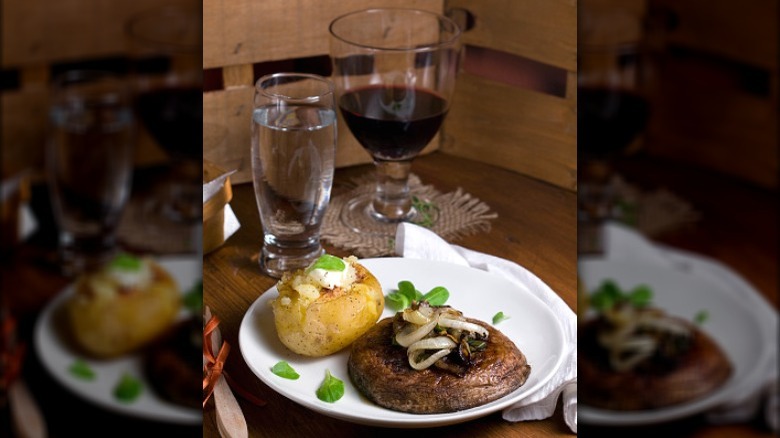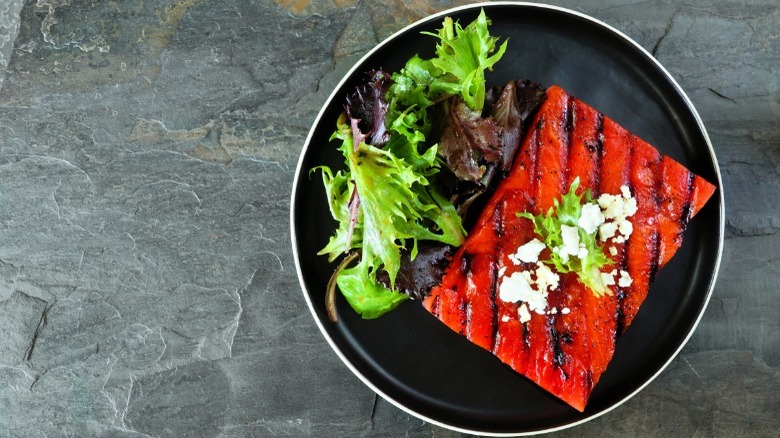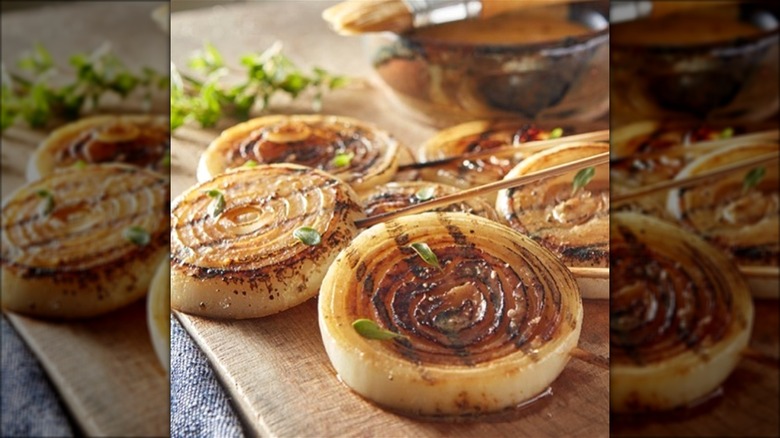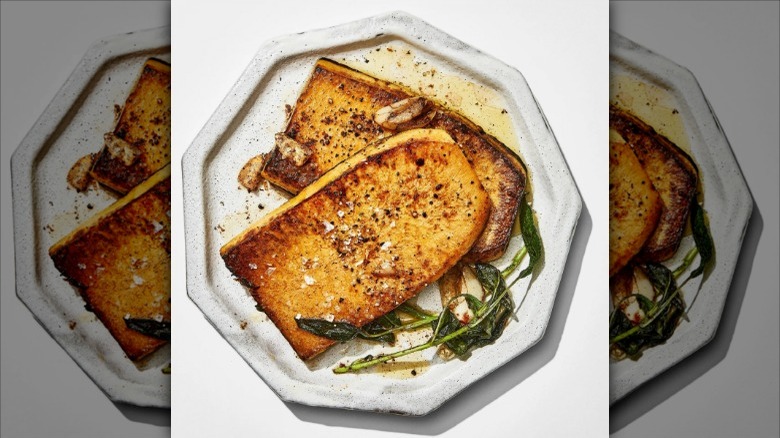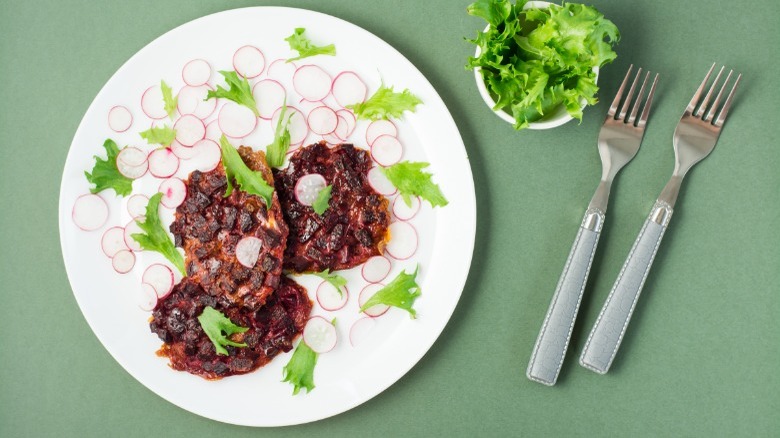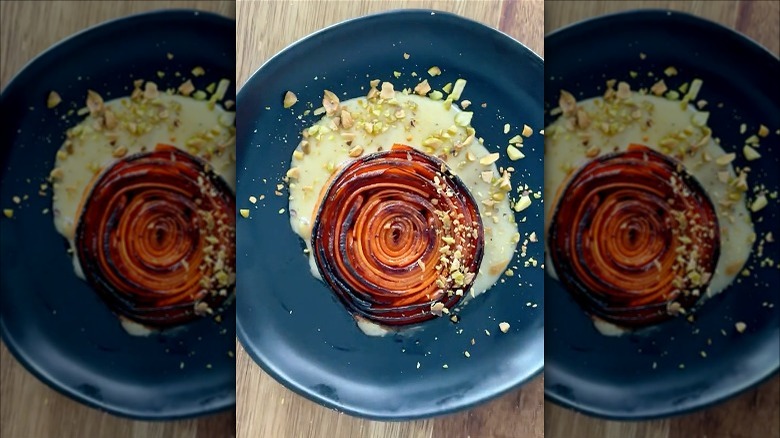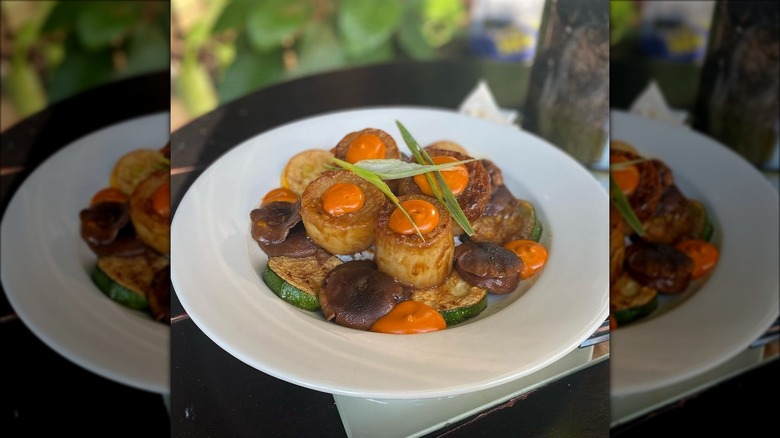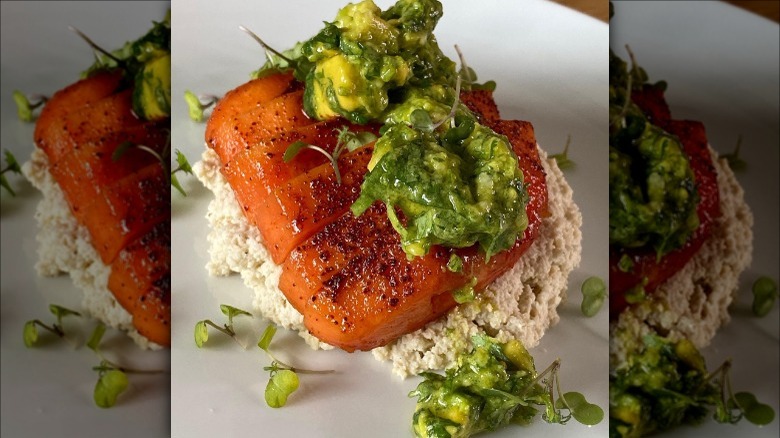The 15 Best Fruits And Vegetables To Turn Into Vegan Steak
The actual definition of steak might be "a chunk of meat sliced from a cow's carcass," but in the realm of vegan gastronomy, that definition is a horror story best left untold. Instead, we're inviting you to redefine the concept of steak, proving that it can be anything you damn well please. Long before seitan's rise to fame or big names stormed the market like Beyond Meat recently did with their steak option, humble veggies, and fungi shouldered the burden of satiating plant-based appetites for centuries. The secret to a good vegan steak lies in umami-rich marinades, robust spice rubs, and the essential art of basting. With these tools, an array of plant-based foods can strut their meat-like potential.
It's important to remember that making a steak from solitary fruits or vegetables demands a mental reset, discarding preconceived notions and expectations that could taint your perception of your painstakingly crafted dish. After all, why should these plant-based wonders aim to perfectly mimic meat? Instead, with some culinary creativity, they can deliver on texture, appearance, flavor, or all of the above, allowing you to whip up arresting vegan entrées that might even charm the staunchest skeptics. So, go ahead, play with your food. The vegan steak revolution is just getting started.
Oyster mushrooms
Mushrooms are a well-known plant-based meat substitute and have been satisfying the umami cravings of vegans for ages. Oyster mushrooms, with their juicy texture and looks resembling dark meat, are known as an excellent fried chicken substitute — but you can easily turn them into an impressively looking steak as well. If working with king oyster mushrooms (also known as trumpets), you'll need to grill diamond-scored and seasoned halves on both sides until golden brown, then pair them with anything from a refreshing green pesto to rich red wine-based sauce or a barbeque glaze.
But here is where it gets interesting: Regular oyster mushrooms have the potential to deliver not only the flavor and texture of steak but the looks, too — and even non-vegan establishments like Wooden Horse Restaurant & Bar have been playing around with it. The trick is pan-searing the whole cluster, with ends lightly trimmed. You can brown them first on a dry or very lightly oiled skillet, and then use another skillet or a plate weighed with cans to really press the mushrooms down onto the hot cooking surface — this will flatten them and ensure even charring on both sides. At this point, you can add desired seasonings such as thyme, garlic, or smoked paprika, as well as vegan butter, and baste until the steaks are cooked through.
Cauliflower
This cruciferous vegetable has been on the plant-based market for some time now — it got a makeover in the late 2010s and went from a sad, soggy, and bland side to a global food trend, in huge part due to the embrace of celebrity chefs like Yotam Ottolenghi. Perhaps that's why many roasted cauliflower recipes have a noticeable Middle Eastern influence: Israeli cauliflower steaks, for instance, are served with labneh, zaatar, and almonds, and Ottolenghi's own recipe pairs them with a tahini-based mash and capers.
But before you season and cook this versatile brassica, you must master the cutting technique, which is the key to an impressive cauliflower steak. First, you'll need to make sure that the ordinarily discarded core stem stays intact — after all, it's the thing that holds everything together. Then, find the right thickness: an inch or so should do it. Anything thinner is at risk of falling apart, and anything thicker won't cook evenly. It's also likely that you'll have to use only the parts closest to the center, leaving you with extra trimmings, which you can roast, pickle, or steam and puree on their own.
Once you've masterfully sliced your head of cauliflower, steam and pan-sear your steaks, roast them in the oven, grill them, or coat them in marinate and air fry to perfection.
Eggplant
This luscious nightshade shines in many vegan 'meat' recipes, from bacon and jerky to gyros and pulled pork. It's such an obvious meat alternative that even die-hard carnivores like Gordon Ramsay opt for it to make a vegan "steak" dinner. As a seasoned chef, Ramsay goes all out, charring eggplants over an open fire, mixing a steak rub from scratch, and roasting the seasoned vegetables whole, complete with a red wine-based basting jus. Going the high-end route takes a lot of time and effort, and although the looks and flavors are worth it, not all vegans are prepared for that kind of kitchen labor.
For a low-maintenance weeknight vegan steak dinner, you can simply roast or pan-fry seasoned eggplant slices. Just make sure to avoid making the thickness mistake: Remember that this water-rich vegetable will massively reduce in size during cooking, so make sure to prep the slices twice as thick as you expect your steaks to turn out. After that, you can either leave the steaks-to-be as they are or instill a diamond-shaped pattern onto them before rubbing them with oil and spices and cooking until soft and evenly caramelized.
Cabbage
While the standard American diet firmly places this humble cousin of the ever-present cauliflower in the coleslaw realm, there is so much more to it. And if you're one of those vegans who doesn't shy away from vegetables, you should be cooking cabbage steaks more often. A telling sign of cabbage being a worthy meat alternative is the fact that it's gaining traction with famous non-vegan chefs. For instance, a famous grillmaster Francis Mallmann included a recipe for steak-like roasted cabbage with a mustard-fennel crust in his 2022 book "Green Fire."
Additionally, making cabbage steaks a part of your dinner repertoire is an affordable way to add more nutrients, especially vitamins K and C, to your diet. Another reason to choose this brassica for your vegan steak is how quick and easy it is to prepare: all you'll need is a tightly packed head of green cabbage, some oil, garlic powder, salt, and pepper. You can build up on this modest base any way you like: by adding more spices or herbs to the mix, charring them on a grill instead of baking, and pairing the steaks with anything from chives and toasted nuts to plant-based bacon and crumbly vegan cheese.
Celery root
Amongst the colorful array of plump carrots, beets, radishes, and sweet potatoes, celery root — with its knobbly, off-putting skin and irregular shape — often gets overlooked. In reality, it's one of those terrible-looking foods that secretly taste amazing, and once you try it for yourself, you'll get hooked. After proper cleaning and trimming, this underdog of the vegetable world is ready to be turned into anything, from a crispy salad to a creamy soup. But its sweet, earthy flavor and meaty texture are really brought forward by slow-roasting, and it's especially evident when you turn it into a vegan steak.
The easiest way to make celeriac steaks would be to slice the prepped root into ½-1-inch slices, score a cross-hatch pattern onto both sides and toss them in the skillet with salt and allium-flavored oil. You can take it one step further by creating a marinade first, and roasting the slices in the oven for about 45 minutes, basting with the marinade throughout. But for a really tender celeriac steak, you want to slow-roast it whole, for 1.5 to 2.5 hours, to let it fully develop its flavor. Then, cut it into thick slabs and caramelize them on a stovetop, basting with herby vegan butter or flavored oil.
Lion's mane mushroom
Once revered for its miraculous health benefits and consumed mainly as a dietary supplement, today lion's mane is the key to your next go-to vegan steak. In its raw state, it looks nothing like meat: on the contrary, it has an innocent look of a fluffy white cloud or — you guessed it — the hair of one majestic feline. But when it comes to vegan steak making, it's unparalleled in terms of looks and texture: the thick, succulent, deeply caramelized slabs of lion's mane could fool any seasoned meat eater — and non-vegan restaurants like Five Leaves in New York City are taking advantage of that. Unfortunately, it's not as affordable or easy to find as other mushrooms, but if you manage to get your hands on it, don't hesitate to experiment with the latest craze in the world of vegan meat alternatives.
The cooking process is similar to that of oyster mushrooms, wherein you use a press to transform the bulbous shape of raw fungi into something more closely resembling a steak. Otherwise, you can implement all the classic steak-making techniques: searing, butter-basting, and flavoring with simple but potent ingredients such as garlic, rosemary, and salt. Don't be afraid to lightly char the surface, sealing all those juices inside.
Jackfruit
Jackfruit has been on a mission to take over the vegan world for years: We've all seen it become a star ingredient in vegan renditions of pulled pork, tacos, crab cakes, and even fried chicken. Its stringy texture resembling meat fibers earned it a well-deserved spot on the list of meat alternatives, but there's a catch. After all, it's a fruit, and you would have a hard time masking its undeniable sweetness under any amount of searing or marinade. Thus, the key to turning it into a savory meat substitute is going for the unripe fruit, which can easily be found in a canned brined form.
Fresh or canned, jackfruit comes with seeds, so it's important to remove them before you proceed. Once you're done taking the seeds out and shredding the flesh, you can cook the seasoned jackfruit meat as is and use it in any dish that would go for torn meat, such as a vegan spin on a Philly cheesesteak. Alternatively, you can mix cooked jackfruit bits with vital wheat gluten, starch, coconut oil, and plant protein powder to form steak-shaped patties, which can then be cooked as you would regular meat.
Portobello mushrooms
Before lion's mane and oyster mushrooms appeared on the scene, portobello steaks dominated vegetarian barbecues for decades. Most mushrooms are easily turned into plant-based meat, and portobellos are no exception. Their large brown caps and naturally umami-rich, earthy flavor make them a beginner-friendly option for creating a whole-food burger patty. Another reason they are a favorable steak substitute is their ability to sustain the heat of the grill and retain just enough moisture to stay juicy and delicious.
While you could toss them with some oil and salt and head straight for the griddle, you might want to marinate the caps first. This way, you'll let the mushrooms do what they do best — soak up the flavors — and enjoy a far more scrumptious steak. The marinade doesn't have to be complicated: You can simply mix soy sauce with sesame oil or olive oil with balsamic vinegar and top it all off with your favorite steak seasoning. Then brush it over the caps and let them rest anywhere between a few minutes and a couple of hours. Once the mushrooms have rested, sear them on a skillet or roast in the oven if you don't have a grill.
Watermelon
You've got to give it to the vegan cooks: Their enthusiasm for creating truly unconventional spins on traditional dishes never ceases. A great example of this is watermelon meat, which, while controversial, has enjoyed viral success over the past few years. Various creators and restaurateurs have demonstrated that watermelon works unexpectedly well on a grill: We've seen tuna, ham, deep-fried katsu, burger patties, and, finally, steak made from this juicy summer staple. And while it is definitely tricky — although not impossible — to make sweet watermelon taste savory, many believe it's worth a shot. At least it's capable of looking the part.
To maintain the illusion better, you'll need to start with a seedless watermelon — no one wants to pick the seeds out of their "meat." Then, to change its expected taste and texture, you would need to brine, smoke, marinate, or dehydrate it (or all of the above, to some degree). An umami-packed Japanese-inspired marinade of soy sauce, rice vinegar, mirin, ginger, garlic, and kombu, can transform watermelon slices, while a combination of a dry rub with a balsamic glaze is best used on a whole melon. The steaks can be roasted in the oven, pan-seared, grilled, and even smoked if your adventurous heart desires.
Onions
Despite being one of the fundamental building blocks of cooking, the onion's role is usually reserved for the supporting cast. Fresh, fried, caramelized, and powdered, it brings all the flavor and texture in the world to the table, yet rarely gets a chance to fly solo. And before anyone gets skeptical, let us just say that this unassuming allium's innate properties — versatility, texture, and the capacity to soak up flavors — make it an excellent vegan steak candidate. Especially if you pick yours up from a local organic food store like Maryland's Common Market.
To make it yourself, you'll need to start with thick (½-1-inch) onion slices, cut crosswise. When subjected to slow roasting and basting, onions melt down into a tender consistency, absorbing aromatic marinades to mimic the savory depths of a traditional steak. But grilling works just fine, too, especially when the slices are doused in a sweet and savory vinaigrette-like glaze (think a combination of agave syrup, mustard, and balsamic vinegar, all of which will help the onions caramelize). Before grilling, you can place two or three raw onion steaks on a skewer and enjoy it as a cutlery-free outdoor treat. Pair this with a smoky grill finish, and you've got a sweet, umami-packed delicacy that can proudly join its meatier counterparts.
Butternut squash
You might not consider butternut squash the ideal vegan steak material. Still, its natural sweetness and earthy tones lend themselves perfectly to a dish that's guaranteed to become a hearty crowd-pleaser, whether or not it has anything in common with a ribeye (it doesn't).
The top part of the squash, devoid of seeds, is used to create thick circular or rounded rectangular slabs, perfect for pan-roasting or grilling. That means no dealing with the bottom part and all the seeds it contains — an infamous butternut dealbreaker. You can leave the slices plain or use a knife to add a diamond pattern to the surface as an additional eye-pleasing detail. Next, sear them in a pan and give them a real steak treatment by slathering butter, sage, garlic, and thyme onto the squash, infusing it with a rich and aromatic flavor. A final spritz of lemon juice brings out the flavors even more. You can serve it as a standalone dish, or pair it with couscous, mushrooms, or wilted greens, turning it into a well-rounded meal.
Beets
With their inherent "meaty" hue, beets are a natural choice for a vegan steak, as evidenced by the frequent use of beet juice and powder as a coloring in homemade and commercial meat alternatives. However, don't overlook the golden beets; they're just as game for this culinary exploration. And with a bit of culinary finesse, the humble beetroot can easily be elevated to steak-hood.
To capture the quintessential steak juiciness, you'll need to roast the beets whole, swaddled in foil to keep them succulent, or cook them over an open fire. Fear not about the skin — a thorough cleaning is all it needs, saving you time and "blood"-stained hands. After slicing them into generous 1-inch pieces, take them to the grill or stovetop to add the irresistible seared touch. Finally, to add more flavor to beets and make them look even more desirable, you can always add a generous layer of glaze: a mix of balsamic vinegar and brown sugar will lock down that caramelization. Once they're ready, pair your beetroot steaks with a garlicky vegan yogurt-based sauce, or a tender vegetable puree, and top with toasted nuts and fresh microgreens.
Carrots
With their natural sweetness and tantalizing tenderness brought out during cooking, carrots make an audacious choice for a vegan steak. Their caramelization potential makes them an ideal match for your oven, grill, or cast-iron skillet.
If you're ready to discover a new side to cooking with carrots, there are several ingenious ways to turn these root vegetables into a vegan steak sensation. The simplest method involves halving a carrot lengthwise, anointing it with oil, salt, and pepper, then roasting it to perfection. Alternatively, you can harness the untapped potential of the otherwise lackluster horse carrots, transforming them into scallop-like bites. To do so, you'll need to parboil, score, season, pan-sear, and baste thick slices of carrot until they're gorgeously browned and tender. Lastly, for a visually arresting presentation, thick carrot ribbons can be rolled into a steak-size circle and pan-fried till lightly charred. Regardless of the method, serve these carrot steaks with a luscious vegan hollandaise sauce or a tender butterbean or potato mash, topped with leftover herby and garlicky plant fat from the pan, and enjoy.
Daikon
If the carrot's transformation into a vegan steak left you fascinated, wait until you hear about the daikon radish. This versatile East Asian vegetable is primed to become the pièce de résistance of your summer barbecues, offering a juicy, vegan alternative to the traditional steak. Available year-round and in various sizes, daikon is both accessible and adaptable, and vegan restaurants like Connecticut's ION have taken note long ago. Just remember to score each steak in a criss-cross pattern before cooking — this allows the radish's mellow flavor to become even mellower while letting your chosen sauces seep into the root's surface. A quick microwave or poach pre-sear ensures the perfect texture.
Daikon naturally pairs well with traditional East Asian ingredients — think a simple rub of sake and kombu dashi for an elevated flavor profile and a last-minute glaze of soy sauce, mirin, and sugar for that umami kick with a glossy finish. But don't be afraid to experiment with familiar favorites — braised mushrooms and greens make an excellent pairing, too.
Papaya
Papaya, often relished in its juicy, ripe form, is now daringly stepping onto the vegan steak scene. Despite its classic role as a meat tenderizer, this tropical fruit is boldly taking up the mantle of the meat itself.
Some chefs with a penchant for bold experiments are pushing boundaries, seasoning this fruit as they would a steak and grilling it in a heady concoction of roasted pineapple and habanero sauce. Other rebels, like Raw Chef Carla, are choosing to keep it raw, or nearly so, dehydrating it for a textural twist that sets it apart from its naturally juicy state. An all-purpose marinade of soy sauce, liquid smoke, sesame oil, syrup, and a whirlwind of spices, left to steep overnight, seems capable transforms the papaya into a vegan steak that challenges taste buds and preconceived notions alike. Pan-seared to perfection, this kind of papaya steak invites you to rediscover the potential of fruit in plant-based meat-making. Give it a whirl, and keep us posted.
Static Media owns and operates Tasting Table and Mashed.
